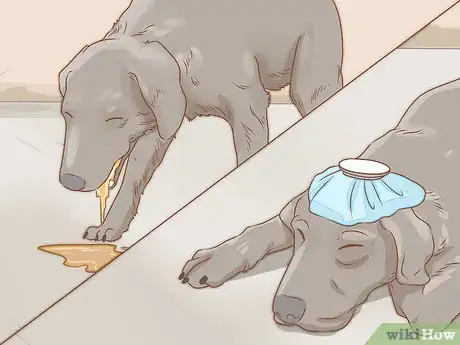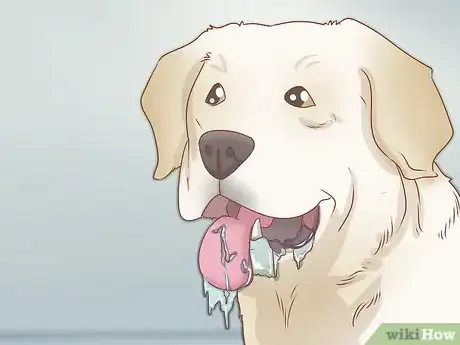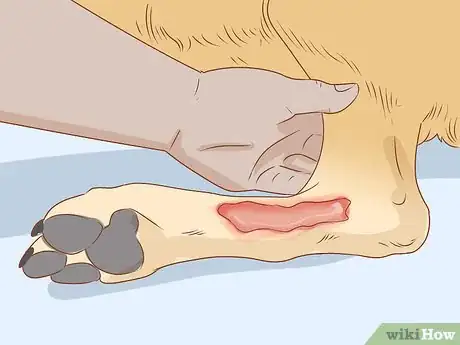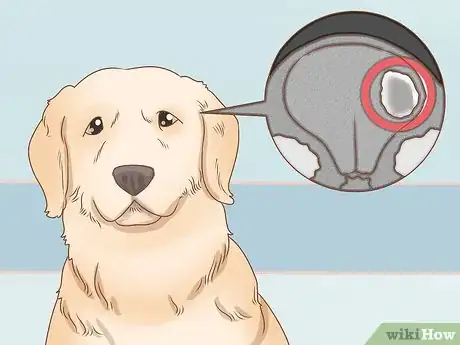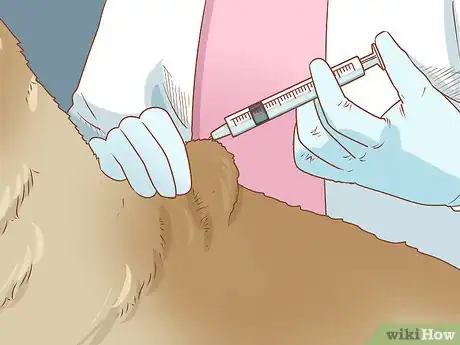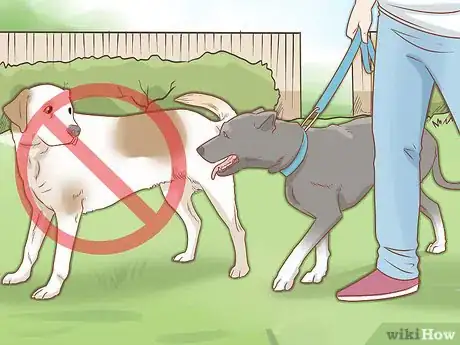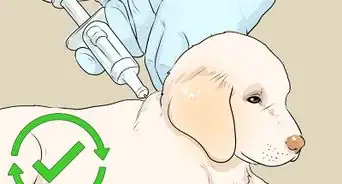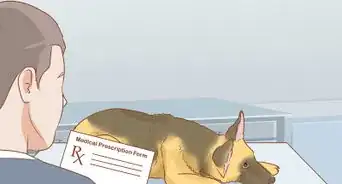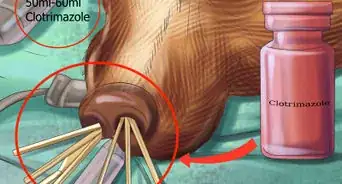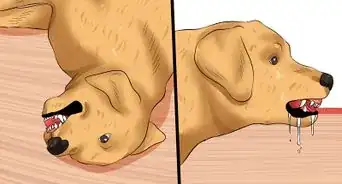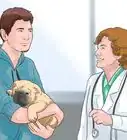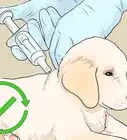This article was co-authored by Ray Spragley, DVM. Dr. Ray Spragley is a Doctor of Veterinary Medicine and the Owner/Founder of Zen Dog Veterinary Care PLLC in New York. With experience in multiple institutions and private practices, Dr. Spragley’s specializations and interests include non-surgical management of cranial cruciate ligament tears, Intervertebral Disk Disease(IVDD), and pain management in osteoarthritis. Dr. Spragley holds a BS in Biology from SUNY Albany and has a Doctor of Veterinary Medicine degree (DVM) from Ross University School of Veterinary Medicine. He is also a Certified Canine Rehabilitation Therapist (CCRT) through the Canine Rehab Institute as well as a Certified Veterinary Acupuncturist (CVA) through Chi University.
There are 13 references cited in this article, which can be found at the bottom of the page.
wikiHow marks an article as reader-approved once it receives enough positive feedback. This article received 11 testimonials and 80% of readers who voted found it helpful, earning it our reader-approved status.
This article has been viewed 360,632 times.
Rabies is one of the oldest known infectious diseases,[1] often affecting wild animals like bats, coyotes, foxes, raccoons, skunks, and even cats.[2] This acute viral disease affects the nervous system and can spread to almost any animal, as well as humans. If your dog hasn't been vaccinated against the disease, he may be at risk if he's been exposed to or bitten by a wild animal. If you believe you see signs of rabies, be cautious and get assistance. You'll also need to contact a veterinarian's office as soon as possible.
Steps
Recognizing Signs of Rabies
-
1Look for early signs of rabies infection. This early stage can last anywhere from two to ten days. During this time, your dog will seem sick with general symptoms. If you notice these symptoms, search your dog for any bite marks or signs of a recent fight (scabs, scratches, ruffled fur with dried saliva). If you find a bite mark or wound of any kind, take your dog to the vet immediately for evaluation. These early non-specific symptoms include:[3]
- Muscle pain
- Restlessness
- Irritability
- Chills
- Fever
- Malaise, a general feeling of sickness and discomfort
- Photophobia, a fear of bright lights
- Anorexia, or disinterest in food
- Vomiting
- Diarrhea
- Inability or unwillingness to swallow
- Cough
- Paralysis of the throat and jaw muscles may follow
-
2Look for later symptoms of the mild form of rabies. This milder form, known as dumb or paralytic form, is the most common and lasts from 3 to 7 days. It's known as dumb or paralytic rabies, because your dog may foam around the mouth or become paralyzed. He'll also seem confused, sick, or lethargic (tired).[4] [5] Take your dog to the vet immediately if you notice any other dumb form symptoms, including:[6]
- Paralysis (inability to move) of the legs, facial muscles, or other parts of the body. This normally starts in the hind legs and moves forward through the body.
- Dropping of the lower jaw, leading to a 'dumb' look.
- Making a strange barking sound that does not sound like a normal bark.
- Excess salivation that creates foam around the mouth.
- Difficulty swallowing.
- Note that in this form of rabies, dogs are not vicious and rarely try to bite.
Advertisement -
3Look for later symptoms of the aggressive form of rabies. This furious or aggressive form also lasts from 3 to 7 days and your dog will appear aggressive or easily excitable.[7] [8] Your dog may behave abnormally and foam around the mouth. This form is what people generally think of when they think of rabies, though it is less common in dogs than the dumb or paralytic form. Furious form creates excessive aggression that must be handled with extreme caution to prevent being bitten. Call animal control to assist you if you think a dog has this form of rabies. Signs include:[9]
- Profuse salivation that will look like foam around the dog’s mouth.
- Hydrophobia, fear of water. The dog will not go near water and will seem uneasy or panicked at the sound or touch of water.
- Aggressiveness. The dog may look like he's trying to bite and will viciously show all his teeth.
- Restlessness or discomfort. He may also be disinterested in food.
- Irritability. The slightest provocation may cause the dog to attack and bite. The dog might even do this without any provocation or cause.
- Abnormal behaviour like chewing on rocks, rubbish or his own legs. The dog may also follow your hand around if you wave it in front of him while he is in a cage. He may try to bite it.
- Overly playful puppies that suddenly bite when petted, and become vicious after a few hours.
-
4Look for any bite marks or open wounds on your dog. When an infected animal bites another animal, rabies is spread through the infected animal’s saliva. When the saliva comes into contact with the uninfected animal’s blood and mucus membranes (mouth, eyes, and nasal cavities) the disease passes from the infected animal to the uninfected animal. Locating any bite marks or open wounds can help you determine if your dog might have been exposed to rabies.
- Once the disease enters the body, it travels by the nerves until it reaches the central nervous system (the spinal cord and the brain).[10] From there, it spreads to the salivary glands where it prepares to spread to another victim.
-
5Get immediate medical attention. If your dog has been bitten, bring him to a veterinarian as soon as possible. The rabies virus can live on the dog’s skin or hair for up to 2 hours, so wear gloves, a long-sleeved shirt and pants before handling the dog. The vet will ask you about possible rabies exposure (like if you've smelled skunks in your yard or your dog has been exposed to any raccoons or bats in the area). Your dog will also be examined.
- If you see signs that a dog that is not yours might be infected, call animal control.[11] This way, the dog can be taken to a veterinarian without putting you at risk for a bite.
- There aren't any tests to determine if live animals have rabies or not. The only test is one in which the brain is removed from the body and small sections of the brain are examined under a microscope for specific signs called Negri bodies.[12]
-
6Know what can medically be done for the dog. Your dog will get a booster shot of the rabies vaccine if he's previously been vaccinated. This will help his immune system fight off the virus. The dog will also be carefully monitored for 45 days, which can usually be done at home. Your dog will have to avoid contact with other animals and humans outside of the household during this time.[13] If the dog hasn't been vaccinated and is bit by a confirmed rabid animal, euthanasia is typically recommended.
- Euthanizing the dog prevents serious health risks to humans and keeps the dog from becoming fully rabid.
- If you refuse to euthanize the dog, it will be quarantined and observed for 6 months, at a willing veterinary clinic. You'll be responsible for the costs and if your dog doesn't become rabid, he'll be vaccinated one month before being released.
-
7Know that there are some diseases that can look like rabies. If your dog does not have any bite marks, but you are concerned about the signs he's showing, be aware that some other conditions can appear like rabies. Take your dog to the vet immediately if he seems sick or is displaying odd symptoms. Diseases and other conditions that could be confused with rabies include:[14]
- Infectious canine hepatitis
- Meningitis
- Tetanus
- Toxoplasmosis
- Brain tumors
- Maternal aggression in females who have recently whelped a litter of puppies
- Poisoning from chemicals such as diminazene or organophosphate
Preventing Your Dog from Getting Rabies
-
1Get your dog vaccinated against rabies. This is the best and cheapest way to prevent your dog from getting rabies. Set up a regular vaccination schedule with your veterinarian to keep your dog’s rabies vaccine up-to-date. Your dog might be on a yearly, every two years or every three years vaccination schedule based on the vaccine manufacturer’s guidelines or state or local laws.[15]
- Many countries have laws requiring dogs to be vaccinated against rabies.
-
2Limit your dog's exposure to wild or stray animals. The best way to keep your dog safe, aside from getting him vaccinated, is to keep him from interacting with wild animals. You might try keeping him fenced in a yard, limiting his time outside when wild animals are more likely to be active (like early morning, evening, or nighttime), and keeping him on a leash when out for walks.[16]
- Pay particular attention to your dog when you take him for hikes or walks through areas where wild animals are common.
-
3Get pre-exposure vaccines for yourself. If you're in high risk area or occupation, you should get a pre-exposure vaccine to protect against rabies. The Centers for Disease Control also recommends pre-exposure vaccination for travelers who stay more than one month in an area of the world where rabies is widespread or if the travelers will work with any kind of animal in these areas.[17] High risk occupations include:
- Veterinarians
- Veterinary technicians
- Rabies laboratory personnel
- People who work with wildlife either at wildlife sanctuaries, rehab centers, or parks
-
4Treat any wounds caused by potentially rabid animals. If you are bit by an animal you think might have rabies, wash the wound with soap and water for 10 minutes. Then, call your doctor's office, who will contact the proper authorities to investigate. They'll also try to capture the animal that bit you for rabies testing.
- If they can't find the animal or it is found and tests positive for rabies, you will be put on a post-exposure vaccine course which varies depending on if you’ve had a previous rabies vaccine or if you haven’t.
Expert Q&A
Did you know you can get expert answers for this article?
Unlock expert answers by supporting wikiHow
-
QuestionHow obvious is it if a dog has rabies?
 Ray Spragley, DVMDr. Ray Spragley is a Doctor of Veterinary Medicine and the Owner/Founder of Zen Dog Veterinary Care PLLC in New York. With experience in multiple institutions and private practices, Dr. Spragley’s specializations and interests include non-surgical management of cranial cruciate ligament tears, Intervertebral Disk Disease(IVDD), and pain management in osteoarthritis. Dr. Spragley holds a BS in Biology from SUNY Albany and has a Doctor of Veterinary Medicine degree (DVM) from Ross University School of Veterinary Medicine. He is also a Certified Canine Rehabilitation Therapist (CCRT) through the Canine Rehab Institute as well as a Certified Veterinary Acupuncturist (CVA) through Chi University.
Ray Spragley, DVMDr. Ray Spragley is a Doctor of Veterinary Medicine and the Owner/Founder of Zen Dog Veterinary Care PLLC in New York. With experience in multiple institutions and private practices, Dr. Spragley’s specializations and interests include non-surgical management of cranial cruciate ligament tears, Intervertebral Disk Disease(IVDD), and pain management in osteoarthritis. Dr. Spragley holds a BS in Biology from SUNY Albany and has a Doctor of Veterinary Medicine degree (DVM) from Ross University School of Veterinary Medicine. He is also a Certified Canine Rehabilitation Therapist (CCRT) through the Canine Rehab Institute as well as a Certified Veterinary Acupuncturist (CVA) through Chi University.
Veterinarian
-
QuestionCan you touch a dog with rabies?
 Ray Spragley, DVMDr. Ray Spragley is a Doctor of Veterinary Medicine and the Owner/Founder of Zen Dog Veterinary Care PLLC in New York. With experience in multiple institutions and private practices, Dr. Spragley’s specializations and interests include non-surgical management of cranial cruciate ligament tears, Intervertebral Disk Disease(IVDD), and pain management in osteoarthritis. Dr. Spragley holds a BS in Biology from SUNY Albany and has a Doctor of Veterinary Medicine degree (DVM) from Ross University School of Veterinary Medicine. He is also a Certified Canine Rehabilitation Therapist (CCRT) through the Canine Rehab Institute as well as a Certified Veterinary Acupuncturist (CVA) through Chi University.
Ray Spragley, DVMDr. Ray Spragley is a Doctor of Veterinary Medicine and the Owner/Founder of Zen Dog Veterinary Care PLLC in New York. With experience in multiple institutions and private practices, Dr. Spragley’s specializations and interests include non-surgical management of cranial cruciate ligament tears, Intervertebral Disk Disease(IVDD), and pain management in osteoarthritis. Dr. Spragley holds a BS in Biology from SUNY Albany and has a Doctor of Veterinary Medicine degree (DVM) from Ross University School of Veterinary Medicine. He is also a Certified Canine Rehabilitation Therapist (CCRT) through the Canine Rehab Institute as well as a Certified Veterinary Acupuncturist (CVA) through Chi University.
Veterinarian
-
QuestionIs rabies deadly to humans?
 Ray Spragley, DVMDr. Ray Spragley is a Doctor of Veterinary Medicine and the Owner/Founder of Zen Dog Veterinary Care PLLC in New York. With experience in multiple institutions and private practices, Dr. Spragley’s specializations and interests include non-surgical management of cranial cruciate ligament tears, Intervertebral Disk Disease(IVDD), and pain management in osteoarthritis. Dr. Spragley holds a BS in Biology from SUNY Albany and has a Doctor of Veterinary Medicine degree (DVM) from Ross University School of Veterinary Medicine. He is also a Certified Canine Rehabilitation Therapist (CCRT) through the Canine Rehab Institute as well as a Certified Veterinary Acupuncturist (CVA) through Chi University.
Ray Spragley, DVMDr. Ray Spragley is a Doctor of Veterinary Medicine and the Owner/Founder of Zen Dog Veterinary Care PLLC in New York. With experience in multiple institutions and private practices, Dr. Spragley’s specializations and interests include non-surgical management of cranial cruciate ligament tears, Intervertebral Disk Disease(IVDD), and pain management in osteoarthritis. Dr. Spragley holds a BS in Biology from SUNY Albany and has a Doctor of Veterinary Medicine degree (DVM) from Ross University School of Veterinary Medicine. He is also a Certified Canine Rehabilitation Therapist (CCRT) through the Canine Rehab Institute as well as a Certified Veterinary Acupuncturist (CVA) through Chi University.
Veterinarian
Warnings
- Treat any bite wound by washing with soap and water and contact your doctor even if you don’t think the animal has rabies. Bites can become seriously infected with bacteria if not treated promptly.⧼thumbs_response⧽
- If a stray dog or cat appears ill do not approach it. You should also wild baby animals since they can carry rabies. Call animal control or the non-emergency police line to have trained professionals with the proper equipment capture the animal.⧼thumbs_response⧽
References
- ↑ http://www2c.cdc.gov/podcasts/media/pdf/EID_2-14-LowHighPathogens.pdf
- ↑ http://www.cdc.gov/rabies/exposure/animals/
- ↑ The Merck Veterinary Manual 9th Edition (2005)
- ↑ Ray Spragley, DVM. Veterinarian. Expert Interview. 29 June 2021.
- ↑ Dürr, S., Mindekem, R., Diguimbye, C., Niezgoda, M., Kuzmin, I., Rupprecht, C. E., & Zinsstag, J. (2008). Rabies diagnosis for developing countries. PLoS neglected tropical diseases, 2(3), e206.
- ↑ Gadre, G., Satishchandra, P., Mahadevan, A., Suja, M. S., Madhusudana, S. N., Sundaram, C., & Shankar, S. K. (2010). Rabies viral encephalitis: clinical determinants in diagnosis with special reference to paralytic form. Journal of Neurology, Neurosurgery & Psychiatry, 81(7), 812-820.
- ↑ Ray Spragley, DVM. Veterinarian. Expert Interview. 29 June 2021.
- ↑ Dürr, S., Mindekem, R., Diguimbye, C., Niezgoda, M., Kuzmin, I., Rupprecht, C. E., & Zinsstag, J. (2008). Rabies diagnosis for developing countries. PLoS neglected tropical diseases, 2(3), e206.
- ↑ Tepsumethanon, V., Wilde, H., & Meslin, F. X. (2005). Six criteria for rabies diagnosis in living dogs. J Med Assoc Thai, 88(3), 419-22.
- ↑ Kayali, U., Mindekem, R., Yemadji, N., Oussiguere, A., Naı̈ssengar, S., Ndoutamia, A. G., & Zinsstag, J. (2003). Incidence of canine rabies in N’Djamena, Chad. Preventive veterinary medicine, 61(3), 227-233.
- ↑ Ray Spragley, DVM. Veterinarian. Expert Interview. 29 June 2021.
- ↑ http://www.vetmed.wsu.edu/ClientED/rabies.aspx
- ↑ https://www.aspca.org/pet-care/dog-care/rabies
- ↑ Dürr, S., Mindekem, R., Diguimbye, C., Niezgoda, M., Kuzmin, I., Rupprecht, C. E., & Zinsstag, J. (2008). Rabies diagnosis for developing countries. PLoS neglected tropical diseases, 2(3), e206.
- ↑ Rupprecht, C. E., & Gibbons, R. V. (2004). Prophylaxis against rabies. New England Journal of Medicine, 351(25), 2626-2635.
- ↑ http://www.cdc.gov/rabies/pets/index.html
- ↑ http://www.cdc.gov/rabies/specific_groups/travelers/pre-exposure_vaccinations.html
About This Article
To spot rabies in a dog, look for signs of a recent fight, like bite marks or open wounds, since rabies is typically spread through animal bites. Then, check for symptoms such as excessive salivating, difficulty swallowing, and muscle paralysis, which are signs of a mild case of rabies. You may also notice symptoms like high levels of aggression and profuse salivation, which may be indications of an aggressive case of rabies. If your dog exhibits any of these signs, take it to your vet as soon as possible to avoid serious health risks to humans and other animals. For more advice from our Veterinary co-author, including how you can prevent your dog from getting rabies, keep reading!
